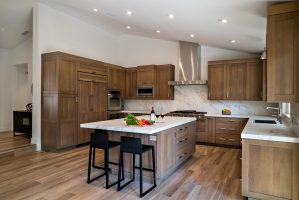 Selecting kitchen cabinets is one of the most important decisions to make when planning a kitchen renovation. We find that there are four factors that homeowners and builders need to consider when selecting kitchen cabinets:
Selecting kitchen cabinets is one of the most important decisions to make when planning a kitchen renovation. We find that there are four factors that homeowners and builders need to consider when selecting kitchen cabinets:
- Budget
- Quality
- Functionality
- Form (look)
Kitchen Renovation Budget
Cabinets are the largest expense in a kitchen renovation, representing approximately 50% of the cost of a kitchen remodel, according to industry surveys. Cabinet budgets are affected by a number of factors. The type of drawers, finishes and options selected will affect costs. We work with every client to help ensure that the budget is sufficient to minimize surprises and to help achieve their goals.
Factors Affecting Cabinet Quality
There are three types of cabinets offered from a kitchen and bath showroom:
- Stock (good)
- Semi-Custom (better)
- Custom (best)
Stock cabinets are pre-manufactured in set sizes, usually in 3-inch increments. Stock cabinets do not have many custom features or options and come in a limited range of styles.
Semi-custom cabinets also are pre-manufactured but generally offer more sizes and options than stock counterparts.
Custom cabinets are built to order without restriction on size, features, finishes or materials.
Another factor influencing quality and price are the materials used to manufacturer kitchen cabinets. These include particle board, medium density fiberboard (MDF), plywood, solid wood and laminate/melamine which is laid over a substrate. Particle board is the lowest quality material, and we do not often recommend it because particle board is not moisture resistant.
Additionally, quality is influenced by the type of construction techniques used to manufacture the cabinet and the durability of the finish which we explain the differences during the selection process.
Kitchen Functionality
A well-designed kitchen is an organized kitchen. A great first step to create an organized kitchen is to write down everything you like and don’t like about your existing kitchen. Most semi-custom and all custom lines provide an array of storage and organizational options for most commonly used kitchen items from food stuffs to cutlery.
Cabinet Forms
There are two types of cabinets: framed and frameless. Framed cabinets have a wood frame that outlines the front of the cabinet box. Hinges and door runners attach to the frame.
Frameless cabinets don’t have a frame. Hinges and door runners attach to the inside walls of the cabinet box. There are benefits to both cabinet types. Frameless cabinets provide more storage area and generally are associated with modern design motifs. Framed cabinets are typically associated with more traditional or transitional designs.